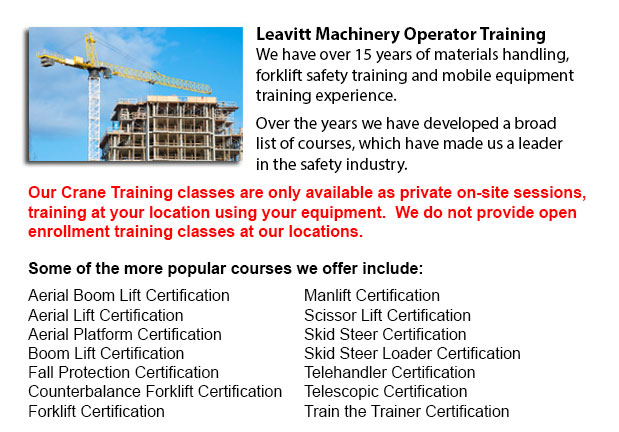
Overhead Crane Operator Training Edmonton - The course teaching overhead crane operator training has been designed specially to instruct trainees on the basics of pre-shift inspections and overhead crane/sling operation. The programs are instructed by expert trainers and consultants. Well-trained workers are more efficient and productive, which saves on costs associated with merchandise damage, property damage, and accidents because of the utilization of incorrect operating measures. Our overhead crane certification is customized for employees who have literacy barriers, reducing certification time by 50 percent.
The overhead crane has been built to be used doing repetitive hoisting activities. This type of crane can be utilized in various capacities. They can be utilized for specialized lifting tasks such as installing or removing major plant equipment.
Operators and worker must employ safe rigging practices to be able to safely operate an overhead crane. This will need both practice and knowledge as the load needs to be properly rigged to guarantee its stability when raised. Before starting a hoisting job, it should be determined that the crane is suitable for the job, with correct lift, capacity and travel. The crane should be subjected to a thorough visual and physical check before utilization. The capacity of all machines, including the slings, hardware and rope, must never go beyond load weight capacities.
The rigger should know the right sling for each lift and inspect slings and other rigging hardware prior to using. Clear signals need to be utilized in communications with the crane operator. A signaler should be chosen for the role and signals need to be agreed upon. The operator of the crane must follow instructions just from the designated individual. If a remote or wired controller is being utilized, the operator should be trained in all its functions.
In order to guarantee the safety of workers, a warning needs to be issued and the path of the load must be cleared of all obstacles before the lift begins. Individuals must not be allowed to walk underneath the lift loads. The crane hoist should be centered over the load prior to lifting in order to prevent swinging. The safety catch must be closed immediately after sliding the sling entirely onto the lifting hook. Unused sling legs should be secured so they do not drag. Never leave loose materials on a load being hoisted. Watch that hands and fingers are clear when slack is taken out of a sling. Before the lift is made, step clear of the danger zone.
-
Forklift Training Programs Edmonton
Forklift Training Programs Edmonton - If you are searching for work as an operator of a forklift, our regulatory-compliant lift truck training programs provide excellent instruction in numerous styles and types of forklifts, classes on pre-shift insp... More -
Heavy Equipment Training School Edmonton
Heavy Equipment Training School Edmonton - The heavy equipment operator courses will assist the operator in acquiring the required skills and knowledge they will require to be able to enter the workforce as an entry level operator. In this 12 week co... More -
Manlift Ticket Edmonton
Manlift Ticket Edmonton - The Elevated Platforms and Manlifts Certification program helps to provide the necessary training on the safe operating procedures, work practice, rules and regulations regarding the daily activities for the operators of thi... More -
Crane License Edmonton
Crane License Edmonton - Crane operators must be "credentialed", which means they must have a crane operator license or certification. Credentialing is considered a mandatory governmental requirement in order to practice as a crane operator. Having a... More -
Counterbalance Forklift License Edmonton
Counterbalance Forklift License Edmonton - When operated by totally trained operators, forklifts could become a major advantage for firms and companies. We could offer your staff a comprehensive training program which covers all aspects of operating... More -
Manlift Safety Training Edmonton
Manlift Safety Training Edmonton - Manlift operators have to be aware and cognizant of all the potential hazards which are associated with particular types of scissor lifts. They need to be able to operate the scissor lift in a way that protects not... More -
Forklift Training School Edmonton
Forklift Training School Edmonton - Forklift Training School And Reasons Why It Is Really Important - Industry and federal regulators have established the criteria for forklift safety training based on their existing standards and regulations. Indivi... More -
Overhead Crane Safety Training Edmonton
Overhead Crane Safety Training Edmonton - The overhead crane safety training course is designed to equip the operators with the right skills and knowledge in the areas of: crane safety precautions, materials handling, accident avoidance, and equipmen... More

Forklift Training Edmonton
crossorigin="anonymous">
TOLL FREE: 1-888-254-6157
Edmonton, Alberta
forklifttrainingedmonton.com
Email Us
About Us


